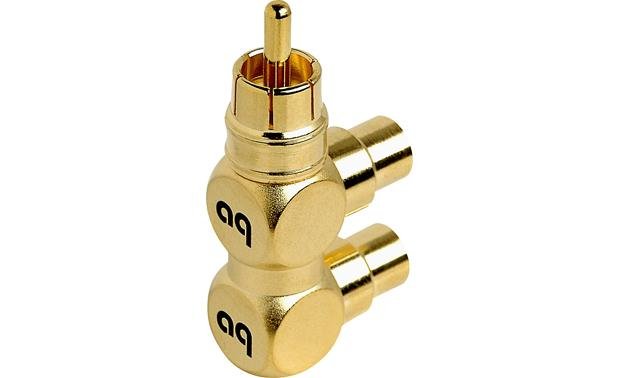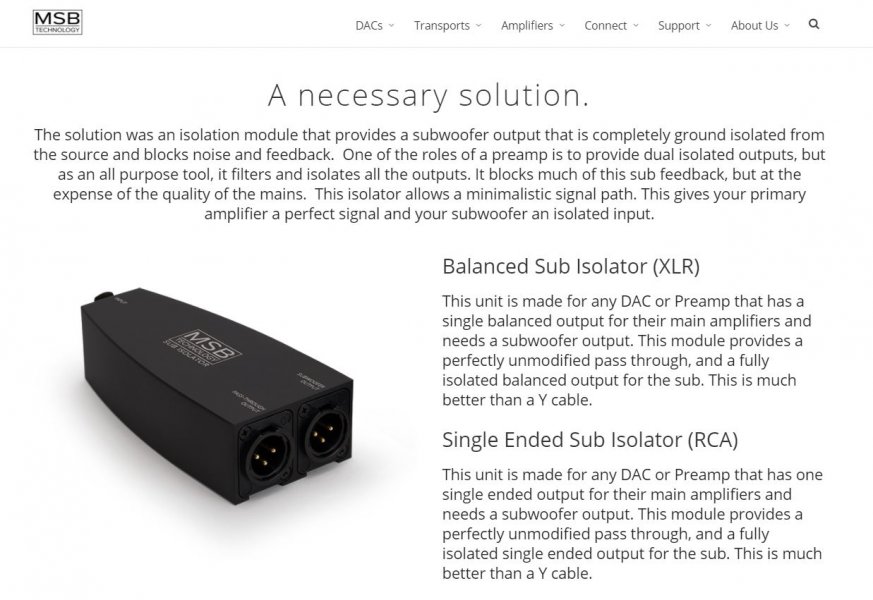Hi David,
I am definitely interested in this thread, as we have used a sub out of one of the preamp outs for years. I am now thinking about what to do to create more isolation/feedback buffer to protect the preamp and amp as this thread has suggested.
Have you looked at this?
https://www.cs1.net/products/jensen_transformers/SUB-2RR.htm
Specifically for subs to go directly just before you go into the sub. I am thinking about this myself.
Additionally for the first time, we have a bit of a ground loop hum issue, and if we disconnect the output from the preamp to the sub...the buzz instantly stops and the system is utterly silent. I am hoping this Jensen piece will put a stop to that buzz.
FROM THE WEBSITE
_______________________
The Jensen Transformers SUB?2RR ISO?MAX 2-Channel Low Frequency Audio Input Isolator is designed specifically for subwoofer amplifier isolation in home theater and automotive applications. The specially designed transformers in this unit provides unparalleled low frequency response while providing over 100dB of common mode isolation, to solve even the most difficult subwoofer installation problems. The zero dB insertion loss also prevents carefully calibrated system levels from being disturbed.
The SUB-2RR is housed is a sturdy metal enclosure, measuring 4.32" W x 2.5" D x 1.45" H., including the flanges. The flanges have mounting holes, which are handy for permanent installations.
If you're not sure which model to choose, please check out our
Jensen Transformers Application Guide.
Please do not confuse the SUB-2RR with similar (but inferior) products. Jensen Transformers' ISO-MAX Studio-Quality Audio Isolators provide the ultimate signal interface solutions. They solve the fundamental problems associated with ground loops, without degrading signal quality.
With inferior products coming from all over the world, we think it is a genuine treasure to find a company like Jensen Transformers, actually designing and manufacturing some of the finest products in the world, right here in the USA, and we are proud to be able to offer their products. The SUB-2RR is made in the USA, is backed by the manufacturer's comprehensive one-year warranty, and has a remarkable 20-year warranty on the transformer device itself.
Ground Loops?
(or why the best planned systems sometimes sound bad)
It is a subject that is seldom discussed in manufacturers publications, or even in magazines of the trade, but ground loops can happen even in the most carefully planned A/V system. When ground loops happen, the result is unwanted hum. This hum is most often heard in powered sub-woofers, but may also be present in the main channels as well. Most powered sub-woofers use a signal-sensing circuit to turn the amplifier off when no signal is present, but ground loops can induce enough hum on the input to keep the amplifier running continuously.
Ground loops are often the result of the fact that sub-woofers tend to be powered by a different electrical branch circuit than the rest of the A/V system. It's easy to understand why, because the sub-woofer may be across the room, and/or it may require so much power that a single branch circuit just isn't enough to handle the load.
The result is that the neutral or ground side of the two circuits can be at a slightly different potential. It can be because one of the circuits is loaded more heavily than the other, or because one run is longer than the other, or any number of other reasons that are beyond the scope of this article.
Ideally, ground loops would be prevented at the design level, but if you are working with an existing room, it is not always possible or practical. Ground loops can occur in a mobile installations as well, because all of the amplifiers in the system have their own internal power supplies, and voltage drop percentages in a 12 volt system can be even more challenging than in a home system.
The Solution
The Jensen Transformers SUB-2RR is elegant in its simplicity. Just insert it anywhere in the audio lines between the receiver or preamp LFE output and the sub-woofer input and it immediately provides these benefits:.
- Eliminates the inherent ground noise coupling mechanism
- Common-mode ground noise rejection of 105 dB at 60 Hz
- Extended low frequency response: -1dB at 0.4Hz, -3dB at 0.15Hz
- Extremely low distortion: 0.01% at 20Hz and -10dBV
- 0dB insertion loss with 600 Ohm source and 47k Ohm load
Immediately, the effects of the ground loop become a non-issue. Problem solved. There are not too many things that one can install in an audio system that can do so much with so little effort. It is a small device, 4.32" long, 2.60" wide, and 1.45" tall, so it fits just about anywhere.
Don't Forget the Cables!
Good cables are very important in the fight against hum and noise. You will need at least two short patch cables in order to insert the SUB-2RR into your signal path, and you may want to consider upgrading your existing cable(s) as well. The SUB-2RR does not include any cables, but if you need them, we have some very high-performance subwoofer cables available. Please
click here to see them!




